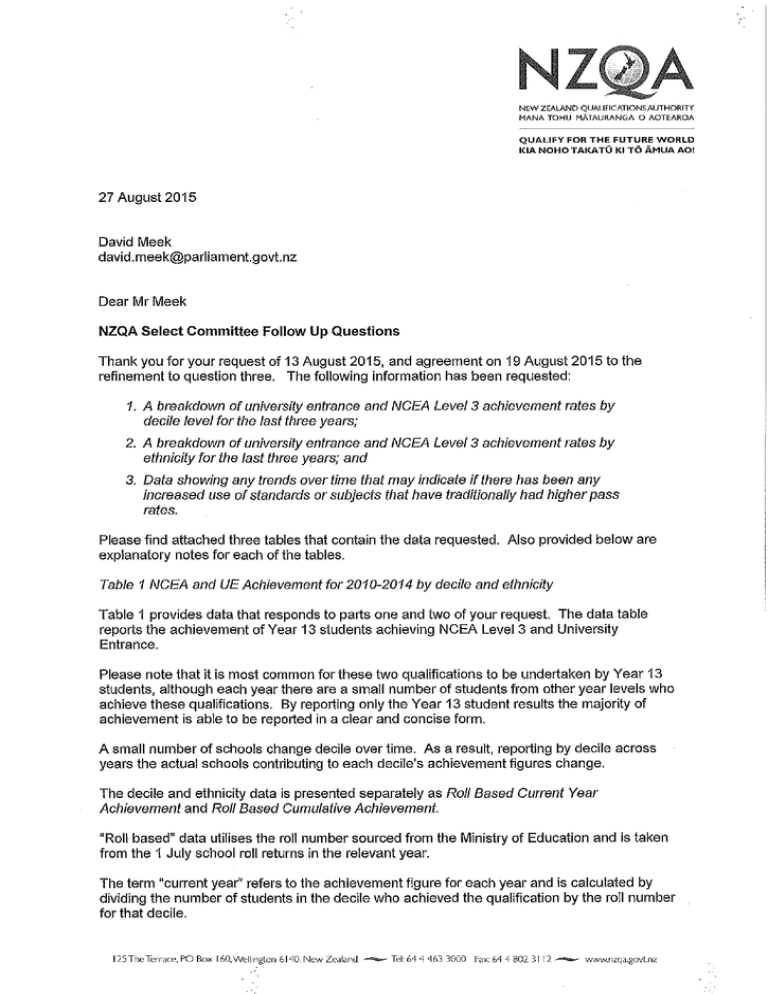27 August 2015 David Meek Dear
advertisement

z NEW ZEALAND QUALIFICATIONS AUTHORITY MANA TOHU MATAURANGA 0 AOTEAROA QUALIFY FOR THE FUTURE WORLD KIA NOHOTAKAT0 Kl TO AMUA AO! 27 August 2015 David Meek david.meek@parliament.govt.nz Dear Mr Meek NZQA Select Committee Follow Up Questions Thank you for your request of 13 August 2015, and agreement on 19 August 2015 to the refinement to question three. The following information has been requested: 1. A breakdown of university entrance and NCEA Level 3 achievement rates by decile level for the last three years; 2. A breakdown of university entrance and NCEA Level 3 achievement rates by ethnicity for the last three years; and 3. Data showing any trends over time that may indicate if there has been any increased use of standards or subjects that have traditionally had higher pass rates. Please find attached three tables that contain the data requested. Also provided below are explanatory notes for each of the tables. Table 1 NCEA and UE Achievement for 2010-2014 by decile and ethnicity Table 1 provides data that responds to parts one and two of your request. The data table reports the achievement of Year 13 students achieving NCEA Level3 and University Entrance. Please note that it is most common for these two qualifications to be undertaken by Year 13 students, although each year there are a small number of students from other year levels who achieve these qualifications. By reporting only the Year 13 student results the majority of achievement is able to be reported in a clear and concise form. A small number of schools change decile over time. As a result, reporting by decile across years the actual schools contributing to each decile's achievement figures change. The decile and ethnicity data is presented separately as Roll Based Current Year Achievement and Roll Based Cumulative Achievement. "Roll based" data utilises the roll number sourced from the Ministry of Education and is taken from the 1 July school roll returns in the relevant year. The term "current year" refers to the achievement figure for each year and is calculated by dividing the number of students in the decile who achieved the qualification by the roll number for that decile. 125The TetTace, PO Box 160,Well_ington 6140, New Zealand -Tel: 6'1 'I '163 3000 fax: 64 4 802 3112 ..-- www.nzqa.govt.nr. The "cumulative" term used indicates that the data also includes students on the roll who had already achieved the qualification in a prior year. Table 2 Student Subject Participation and Achievement for 2010-2014 Table 2 provides a breakdown by Subject and Standard Level and includes three measures that are defined below. "Achievement rate" represents those students who are deemed to be participating in the subject because they were assessed for 14 or more credits from standards in the subject at this level. "Assessed students" represents the number of students participating in the subject. The "percentage of total students" data represents the proportion of all students, regardless of Year Level who were participating in this subject at this standard level. This provides some measure of the uptake of this subject and any variation across years might suggest a movement to or away from the subject. Please note that the data provided for the Maori language learning area shows three subject headings of Maori, Reo Maori, and Te Reo Maori. Students have been assessed against individual standards spread across the three subject headings between 2010 and 2014. Table 3 Student Entry and Achievement Rates in Level3 Standards for 2010-2014 This table provides a breakdown by Subject, Standard Level, and Standard Number and includes four measures that are defined below. The "Standard achievement rate" is calculated by dividing the number of students with an Achieved, Merit or Excellence result in the standard by the number of students assessed in the standard. "Students Assessed in the Standard" refers to the number of students assessed in the standard. "Students Assessed in Subject/Level" represents the number of students who were assessed for 14 or more credits from standards in the subject at this level. The "percentage of participants in subject assessed in standard" shows the proportion of students who were participating in this subject, at this level, who were assessed in this standard. Any variation of this percentage across time could indicate that the standard was more or less popular. Comment It is important to note that the standards alignment project made significant changes to the standards available to be used in secondary schools. This project delivered a revised set of Level 1 standards in 2011, Level 2 standards in 2012 and Level 3 standards in 2013. The change in standards included the expiration of many standards, both Unit and Achievement standards, the creation of new Achievement standards, and a shift from internal assessment to external assessment and vice versa for some Achievement standards. If you require further assistance or believe we have misinterpreted your request, please contact Colin Daniel, NZQA Advisor Chief Executive and Ministerial Services. Colin can be contacted by email at colin.daniel@nzqa.govt.nz. Yours sincerely Karen Poutasi (Dr) Chief Executive Encl. Table 1 - NCEA and UE Achievement for 2010-2014 by Decile and Ethnicity Table 2- Student Subject Participation and Achievement for 2010-2014 Table 3- Student Entry and Achievement Rates in Level3 Standards for 2010-2014
